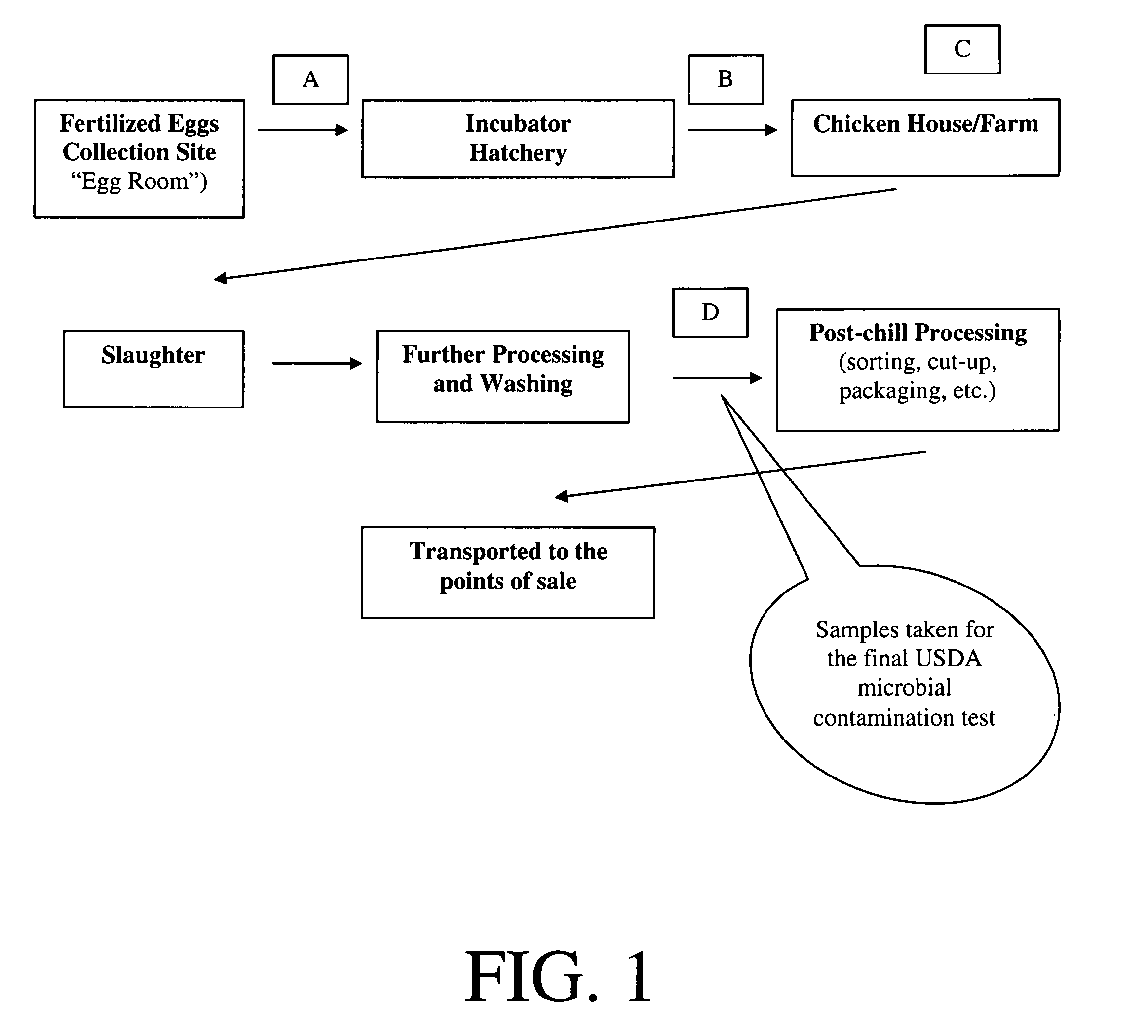Method and device for sanitation using bacteriophages
a technology of bacteriophage and sanitizer, which is applied in the field of bacteriophage, can solve the problems of untreatable strains of vre, and untreatable strains, and achieve the effects of preventing colonization and invasion of laying hens, reducing salmonella contamination levels, and protecting against salmonella colonization
- Summary
- Abstract
- Description
- Claims
- Application Information
AI Technical Summary
Benefits of technology
Problems solved by technology
Method used
Image
Examples
example 1
Obtaining VRE Isolates
[0158] Isolation of VRE
[0159] VRE were isolated by standard methods from patients in the surgical intensive care and intermediate care units of the University of Maryland Medical Center in Baltimore. Trypticase Soy Agar supplemented with 5% sheep blood (BBL, Cockeysville MD) was used to isolate enterococci from urine, wounds and sterile body fluids. VRE were isolated from stool specimens on Colistin Nalidixic Acid (CNA) agar (Difco labs, Detroit, Mich.) supplemented with defibrinated sheep blood (5%), vancomycin (10 μg / ml ) and amphotericin (1 μg / ml). See Facklam, R. R., and D. F. Sahm. 1995. Enterococcus. In: Manual of Clinical Microbiology, 6th edition, American Society for Microbiology, Washington, D.C., pp. 308-312.
[0160] Identification of VRE
[0161]Enterococci were identified by esculin hydrolysis and growth in 6.5% NaCl at 45° C. Identification to the species level was done using conventional testing as indicated in Facklam and Collins (Facklam, et al....
example 2
Isolation of VRE Phage
[0166] 500 ml of raw sewage from the University of Maryland is mixed with 100 ml of 10 times concentrated LB broth (Difco Laboratories). This sewage-broth mixture is inoculated with a 18-24 hour LB broth culture (1 ml) of a VRE strain and incubated at 37° C. for 24 hours to enrich the mixture for bacteriophage which can infect the VRE strain added. After incubation, the mixture is centrifuged at 5000 g for 15 minutes to eliminate matter which may interfere with subsequent filtration. The supernatant is filtered through a 0.45 μm Millipore filter. Filtrate is assayed using the Streak Plate Method and / or Appelman Tube Turbidity Test to detect lytic activity against different strains of VRE.
[0167] Method for Testing Phage Against VRE Isolates
[0168] Three methods are employed: Plaque Assay; Streak Plate Method; and Tube Turbidity Method, and the procedures for each follow.
[0169] Plaque Assay:
[0170] A 18-24 hour nutrient broth culture of the VILE strain (0.1 ml...
example 3
A Phage Strain is Active Against Over 200 VRE Isolates
[0178] A collection of 234 VRE isolates; 187 E. faecium of which 3 strains are from ATCC, 41 E. faecalis strains, and 6 E. gallinarium strains as well as 6 E. faecium strains which are vancomycin sensitive were tested for susceptibility of infection by 7 monophages isolated as described in Example 2. Susceptibility of infection was determined by the 3 techniques described. The majority of VRE strains in this collection were isolated from patients at the University of Maryland and Baltimore VA Medical Centers as indicated in Example 1. Such VRE isolates were determined to be distinct and genetically diverse by pulsed field gel electrophoresis typing. Of the 7 monophages, VRE / E2 and VRE / E3 have a relatively narrow host range compared to other VRE phages, but are able to infect the small proportion of VRE strains which were resistant to other phages collected. A phage cocktail containing the above 7 VRE monophages lysed 95% of the ...
PUM
| Property | Measurement | Unit |
|---|---|---|
| time | aaaaa | aaaaa |
| temperatures | aaaaa | aaaaa |
| minimum inhibitory concentration | aaaaa | aaaaa |
Abstract
Description
Claims
Application Information
 Login to View More
Login to View More - R&D
- Intellectual Property
- Life Sciences
- Materials
- Tech Scout
- Unparalleled Data Quality
- Higher Quality Content
- 60% Fewer Hallucinations
Browse by: Latest US Patents, China's latest patents, Technical Efficacy Thesaurus, Application Domain, Technology Topic, Popular Technical Reports.
© 2025 PatSnap. All rights reserved.Legal|Privacy policy|Modern Slavery Act Transparency Statement|Sitemap|About US| Contact US: help@patsnap.com

